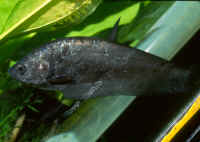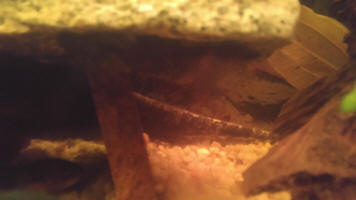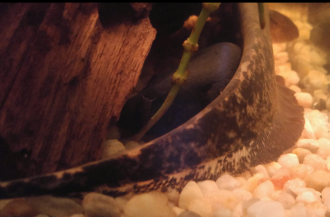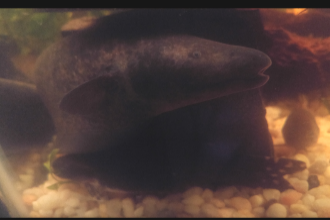|
FAQs on
Knifefish
Identification
Related Articles: Knifefishes, Gymnarchus, Black Ghost Knife,
Electrogenic
Fishes,
Related FAQs: BGK ID, Knifefishes 1, Knifefishes 2, Knifefish Behavior, Knifefish Compatibility, Knifefish Selection, Knifefish Systems, Knifefish Feeding, Knifefish Disease, Knifefish Reproduction, Electrogenic Fishes,
|

|
|
Identifying knife fish
12/1/16
Hi my lfs recently ordered a fish for me. At first they said it was a
mousehead knife but after doing some research I discovered that there is
one called mousetail however when the owner talked to the distributer
they said it was a granite knife so i did research to make sure i could
take care of it properly. Unfortunately it was not a granite. I have
searched
the internet and can not find what it is. It kind of resembles a ghost
knife. It is about 8 inches but really thick. He's black with a stripe
on his back like a ghost knife however his tail looks speckled with
white. It kind of looks like someone threw paint on the last couple
inches of his tail. His mouth looks similar to a ghost also but it looks
bigger. I would take a picture but he's hiding. If you have any
knowledge on what he could be i would appreciate it so much. I want to
take care of him properly. I have him in a 45 gallon which is too small
for him but i wasn't expecting to get one quite so large so i thought i
would have time to save money to buy a bigger tank. Hope to hear from
you soon. Thank you,
Jessica
<Hi Jessica. Really do need a photo here. If the fish has a stripe along
the back, but isn't as black as Apteronotus albifrons, it might be one
of those sister species imported less often, such as Apteronotus
leptorhynchus or Apteronotus bonapartii. Alternatively, the Granite
Knifefish name has been used for certain Steatogenys species. These are
mostly smallish (around 30 cm/12 inches) species, a bit delicate with
regard to water chemistry, though otherwise unproblematic fish
occasionally maintained by expert fishkeepers with access to live or
frozen foods. Cheers, Neale.>
Identifying knife fish... 26 megs....
12/18/16
Jess; have deleted your email as it uses more than half our allowed
bandwidth/space. Please resize your pix to a few hundred Kbytes and
re-send all. Bob Fenner
Re: Identifying knife fish 12/19/16
Hi I'm not sure how do that. Would it help if I uploaded them to Imgur
and sent you the link?
Jessica
<Ah yes; thank you. That will do splendidly. BobF>
re: Identifying knife fish 12/19/16
For some reason the WWM emailer is cropping my message. Pasted below.
Cheers, Neale
--------
<<I would also have you use the tools at *your* disposal; assuming these
are South American, then review the families within the Gymnotiformes,
excluding the highly distinctive Electrophoridae (one species: the
electric eel). To wit; Fishbase; the family entries, set to show photos
of the species; some are blank, but such fish are unlikely to be traded.
A powerful tool that takes a few minutes to learn, and what I would
probably end up using to identify your fish if it isn't obviously one of
the commonly traded species.
http://www.fishbase.se/identification/specieslist.php?famcode=545&areacode=
http://www.fishbase.se/identification/specieslist.php?famcode=546&areacode=
http://www.fishbase.se/identification/specieslist.php?famcode=547&areacode=
http://www.fishbase.se/identification/specieslist.php?famcode=548&areacode=
These families/this order is pretty consistent. Assuming it isn't one of
the big predators (Gymnotus spp. for example) these are medium-sized,
territorial but fairly to very social (in groups of 5+) fish; fairly to
highly sensitive to poor water quality and low oxygen level; timid;
nocturnal; usually picky feeders with a requirement for live or frozen
invertebrates rather than flakes/pellets. Not difficult to keep if their
very specific requirements are understood (well oxygenated but deep
tanks; ideally with low to moderate hardness, acidic to neutral pH).
Eigenmannia virescens is very typical of the majority of species, rather
more so than the bigger Apteronotus albifrons, which is more routinely
kept. Commonalities to both outlined above; many sold, many bought, few
survive more than a few months in either case. Poor to non-community
fish; not impossible to keep, but do require some thought, understanding
and experience. Cheers, Neale.>>
Re: Identifying knife fish 12/19/16
Hi Neal, thank you for those links however he is not like any of those
pictures. I had sent a few pics of him but I guess they are too big so
I'm trying to figure out how to upload to Imgur and I will send you the
links.
Thank you,
Jessica
<Mmm; Jess; there are a few ways to re-size images... One simple online
program here: http://imageresize.org/
Do you use/have a Mac or Windows machine? BobF>
Re: Identifying knife fish 12/19/16
Hi Neal, thank you for those links however he is not like any of those
pictures. I had sent a few pics of him but I guess they are too big so
I'm trying to figure out how to upload to Imgur and I will send you the
links.
Thank you,
Jessica
<Understood. As/when you have some photos uploaded or mailed to us, I'll
take a look. Cheers, Neale.>
Re: Identifying knife fish
6/20/16
Hey I uploaded it online instead because I don't have a computer and
here's the link.
Knife fish
https://imgur.com/gallery/2cCgk
Jessica
<These really are too blurry, Jessica, to do much with. The shape of the
tail (e.g., does it end in a thread-like extension) is important, as is
the shape of the snout (e.g., is it robust and rounded, or drawn out
into a beak-like shape). Can't see either of these features. I'd be
looking at Gymnorhamphichthys, Rhamphichthys and Steatogenys in the
first instance,
seeing what Google throws up. I'd also look at Gymnotus species too,
though these are usually bigger and certainly more aggressive fish. At
the end of the day, while Gymnotus is a fairly tough fish, all the
others are fairly to very delicate fish that can't be weaned onto
pellets or flakes, and do need highly oxygenated water to do well. So
there's really not much to say about individual species, and maintenance
is very consistent. Some variation in adult size, but most are fairly
small, 30 cm/12 inches tops, the exceptions being Apteronotus spp.
Cheers, Neale.>
Re: Identifying knife fish
Hi did you guys get the link I sent? If not I'll send it again. Thank
you
Jessica
<Do check your email in box; have replied. Cheers, Neale.>
|

|
Re Identifying Knifefish 1/7/17
Hi guys, so awhile back I had sent you guys some pics of my knife fish but
unfortunately they were too blurry but finally I got some good shots and
uploaded them to Imgur. I'm really hoping you can tell me what he(she) is since
I have spent countless hours on the internet and talking to others in the hobby.
Hope to hear from you soon.
Jessica
https://imgur.com/gallery/4e7WE
<Not 100% sure, but think that this is Apteronotus leptorhynchus, also known as
the Brown Ghost Knifefish. Basic care identical to the Black Ghost Knifefish,
but looks a bit different and only gets to about 30 cm in length. But does have
a similar beaky-sort of face to the Black Ghost. Does the fish have a pale band
running along its back? If so, definitely
Apteronotus leptorhynchus. Has the 'flag like' tail fin of Apteronotus species
though, and looks to be a fairly big fish, which again accords with Apteronotus.
By contrast Gymnotus species have tails that taper to an almost needle-like
point. Let me direct you again to Fishbase, the Apteronotidae species list,
which has photos at top and also a list of
species with standard lengths at the bottom. Should help you.
http://www.fishbase.org/identification/specieslist.php?famcode=545&areacode=
Cheers, Neale.>
|

 |
|
Re: Identifying Knifefish
1/8/17
Thanks for getting back to me Neal,
<Welcome.>
I really appreciate it! I looked at the brown ghost knife and he does look
similar however the stripe that runs down the body starting at the mouth is not
the same on him. He has a very light line but it doesn't start until the back of
his head and it doesn't run down his entire body to the tail.
<So I think we can agree he's related to Apteronotus leptorhynchus, if not quite
that species.>
Also his coloring is definitely different than the brown ghost knife. He is
black/grey with white splotches down the bottom half of his body. As you said he
is pretty large and his width is 4 inches and he's about 11 inches.
I have him in a community tank right now because I started a new tank for him
but I'm in the middle of cycling it right now and I don't want to put them in it
until it's done cycling so he's in with smaller fish and he's very peaceful with
them except sometimes they won't leave him alone going in his cave so sometimes
he uses his head to ram them out.
<Standard operating procedure for most electric fish, to be honest!>
I also saw him open his mouth once and it's huge!
<Do please check Gymnotus as well as Apteronotus; the two are fairly similar in
body shape, though their tails are different. Gymnotus has a big, big mouth --
as befits a confirmed fish-eater. Gymnotus also tend to be territorial and
aggressive, which doesn't sound much like your chap, but on the other hand, a
variety of Gymnotus species are commonly traded, most of which lack common
names.>
I was wondering if it's at all possible that he's a hybrid?
<Possible.>
Would different species of knife fish spawn in the wild?
<Yes, but it's uncommon for all sorts of reasons. Still, it does happen.
What is more likely is a related but different species of Apteronotus, or a
subspecies of Apteronotus leptorhynchus even.>
I know most don't care for the company of each other but he looks so different
than any I've seen. His head kind of looks like a dinosaur.
Thanks again for helping me out with this!
Jessica
<Cheers, Neale.>
Re: Identifying Knifefish; now fdg. 1/8/17
Neal, thanks for such a quick reply. So I have one more question. I feed him
live black worms which he happily slurps up. Is there any other foods I can give
him?
<Definitely needs more variety than this! I'd be looking at earthworms and
gut-loaded river shrimp as staples, and if he takes frozen foods as well, such
as krill or Spirulina-enriched brine shrimp, that'd be great.>
Sometimes I have given him blood worms but I know they shouldn't be a everyday
food. I won't do feeder fish as they carry parasites but what if I breed guppy's
or something similar for him to eat or is this unnecessary?
<In theory home-bred Guppies are safe, but in fact not necessary, if for no
other reason they're more likely to encourage him to view fish as food, which
could cause problems for tankmates. In the wild Apteronotus are more
micro-predators than anything else, and benthic invertebrates such as insect
larvae are probably their main food. They do have substantial appetites though,
so do keep an eye on how rounded his belly looks.
Slightly convex is what you're after, rather than bloated, but shouldn't be
concave either.>
I just want to give him what he needs and deserves.
<Understood and he looks a great fish! Big adult Apteronotus are impressive, and
intelligent, animals that make rewarding pets. They can become quite tame, and
electric fish often become rather quirky as they settle in, with distinct
personalities. At least some species have brain to body weight ratios similar to
mammals, suggesting a high level of intelligence, by fish standards, anyway.
Cheers, Neale.>
|
|
Info on Sternarchorhamphus macrostomus. Platyurosternarchus
(formerly Sternarchorhamphus) macrostomus 8/23/07 Hello
all. <Hi.> Well, I do a lot of the ordering at a store I work at,
and I managed to get in two Knifefish under the name 'elephant
knives'. The species appears to be Sternarchorhamphus macrostomus,
but the problem is I cannot locate ANY information on this fish outside
of the limited info under the picture in Axelrod's Atlas.
<Likely one reason is that the genus is considered to be
Platyurosternarchus by some. Using this name will bring up more hits in
databases and the net, although not as much information as you would
certainly like to have. In addition a proper ID is not easy. Also have
a look on other members of the Apteronotidae or Gymnotiformes in
general
(http://www.wetwebmedia.com/FWSubWebIndex/knifefishfaqs.htm).> I
only managed to get 2, and I cannot get more, so I'm thinking very
seriously of getting them for myself. <Certainly very rare if this
species.> I was wondering if anyone here has any information on
these fish. <Not much, but I'd expect it to be similar to more
common ghost knives and other neo-tropical knife fishes. Likely will
attain 15' and is slightly electric. Would not keep it with other
electric fishes. Many occur in groups and use their electric organ to
communicate, so I would not separate the two specimens you have. Small
fish will probably be eaten. Plenty of floating plants would help them
to feel comfortable, since many are nocturnal. Males are usually much
larger. Breeding possibly can be triggered by imitating rain
season.> They are feeding well on frozen/thawed bloodworms right out
of my hand, and as far as I can tell are showing no aggression towards
one another. <Great.> Thanks for any help you can give! <Have
fun with your new fish. Seems you are doing some pioneer work.
Marco.>
Steatogenys duidae Hello,
I was wondering whether you
might know anything about a certain Knifefish "Steatogenys
duidae", I saw it listed as the Centipede Knifefish at "Zang
exotic Fish Company" but can't find information about it
anywhere else, (and i think a seller's information should always be
treated as a little suspect just to be safe). I know you should always
research a fish before you even consider buying it but this species has
got me stumped. Would it work in a 55gal community tank? Thank you
J Dunlap <Mmm, IS a valid genus,
species of Hypopomid knife... I suspect it's care is very similar
to the ever-popular Black Ghost Knifefish. On Fishbase:
http://www.fishbase.org/Summary/SpeciesSummary.cfm?ID=48119&genusname=Steatogenys&speciesname=duidae
A fifty should work out fine... subdued lighting, live foods, soft,
acidic water, an absence of metal dye medications... Bob Fenner>
Ghost Knife Hi, I recently bought a new fish from a local pet
store and he is doing just fine. The guy that sold it to me
said it was a Black Ghost Knife fish, although the fish does not have a
white stripe down its back or a white band around its tail. It does,
however, have a very dark brownish red stripe where the white one
normally is and no band of color on the tail. The fish's body is
jet black. Is this a Black Ghost? If you know the answer could you
email me back? Thanks! <Hmm..., not quite sure, do you have a
picture? Check out Monga bay and Fishbase to see if you can
find a match. -Gage http://www.mongabay.com/fish/knifefish.htm
http://fishbase.org >
UFS (Unidentified Freshwater Specimen) Hello again, Mr.
Fenner! On my yesterday's trip to my LFS I spotted in one of the
freshwater tanks, along with some Discus, a black sort of "file
fish" thin) around 2" long; it also had a white stripe near
the head and a peculiar way of swimming, since it only uses a long
ventral fin to do it. Not recognizing the species I asked the employee
the name of it. The answer was: "It's a Roberty... but
that's all I know!". Can you please give me any clue of it is,
or a positive ID of this specimen??? <Umm, sounds like a "Black
Ghost Knifefish" to me: Apteronotus albifrons. Please take a look
on the net (at least fishbase.org) under these names. Bob Fenner>
Thank You, best regards ! Luis Santos
Knife fish cheerleaders? (04/21/03) I have just recently
purchased a knife fish from the local petstore. The fish was called a
"Pom Pom Knife fish" but I have searched all over the
internet and not found anything. <I'm finding a lot on knife
fish, and even more on pom poms, but nothing about pom pom knife
fish... nothing on cheerleader knife fish, either.> The fish looks
exactly like the Black Ghost Knife fish but mine doesn't have the
white tail and isn't electric. I was wondering if you might know of
a fish that is quite similar to the Black Ghost Knife fish so I can see
if it is what I have and find out how to take care of it. <Try this
site for descriptions of several types of knife fish: http://www.mongabay.com/fish/knifefish.htm>
Thanks, <You're welcome. --Ananda>
|
|

